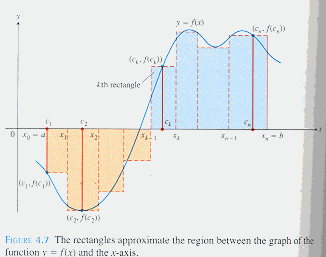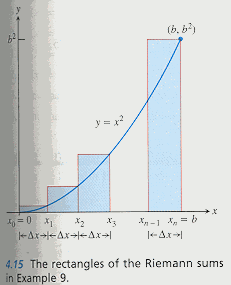Average (Mean) Value of a Function
Rules for Definite Integrals
Riemann Sums and Definite Integrals
Given the continuous function
into
subintervals, as shown in the figure below.
the

The area of a rectangle is length times width.
For a representative rectangle, the width is
and the length, or height, is
so its area is
The expression
called a Riemann sum,
gives the sum of the areas of all the rectangles shown in the figure.
This sum gives an approximation of the algebraic area under the graph of
bounded by the x-axis and the vertical lines
Now take the limit:
If we simultaneously let the number of subintervals increase beyond all bounds
- go to infinity -
and the length of each subinterval go to zero, and if this limit exists,
that is, is a finite number, this limit is called the definite integral of
 ,
,where
that is, the maximum value of the lengths of the subintervals.
Example
1] Find the area of the region between the parabola
 tiff
tiffPartition
into n subintervals each of length
The points of partition are
The choice of the
in the subinterval
is arbitary , choice a point that makes the algebra as easy as possible.
Let
be the endpoints of each subinterval.
So the areas of the corresponding rectangles are:
is the area of the first rectangle.
is the area of the second rectangle.
.
.
.
is the area of the
.
.
.
is the area of the last, or
The sum of these areas approximates the precise value of the area under the curve.
the summation index
With respect to the summation,
At this point, we need to use the summation formula
 .
.Remember that
So
To get the exact value of the area under the curve, we let the number of subintervals
go to infinity,
and the maximum length (the norm) of the subintervals go to
This value is the value of the definite integral.
2] For a particular vale of
as giving the area under the graph of
or simply as the value of the definite integral.
See Example 3, page 345.
Another application of the definite integrals to define the
Average (Mean) Value of a Function
If the integral of a function exists on
Example
3]
The average value of
When we study the Fundamental Theorem of Calculus in the next section,
we will learn a relatively easier way of calculating this definite integral.
For now, we can find it using the definition of a definite integral as the limit
of a Riemann sum. But that would require a bit of algebra!
Here's an easier way:
The graph of
is the upper semicircle of radius
The geometric interpretaion of the definite integral is as the area of the
semicircle from
From plane geometry, the area of this semicircle is
So
Rules for Definite Integrals
1] Order of Integration:
2] Zero:
3] Constant Multiple:
4] Sum and Difference:
5] Additivity:
6] Max-Min Inequality:
If
7] Domination:
If
In particular, if
See Examples 5, page 348.
next The Mean Value and Fundamental Theorems
Top